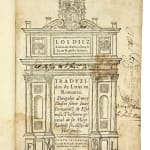![Alberti, Leon Battista, Los Diez Libros de Architectura de Leon Baptista Alberto. Traduzidos de Latin en Romance, 1582. S.l. [Madrid]. Con Privilegio En Casa de Alonso Gomez Impressor de su Magestad.](https://artlogic-res.cloudinary.com/w_1600,h_1600,c_limit,f_auto,fl_lossy,q_auto/artlogicstorage/hsrarebooks/images/view/4d17cfe4cb3993317da94b2745366cf8j/hsrarebooks-alberti-leon-battista-los-diez-libros-de-architectura-de-leon-baptista-alberto.-traduzidos-de-latin-en-romance-1582.-s.l.-madrid-.-con-privilegio-en-casa-de-alonso-gome.jpg)
![Alberti, Leon Battista, Los Diez Libros de Architectura de Leon Baptista Alberto. Traduzidos de Latin en Romance, 1582. S.l. [Madrid]. Con Privilegio En Casa de Alonso Gomez Impressor de su Magestad.](https://artlogic-res.cloudinary.com/w_1600,h_1600,c_limit,f_auto,fl_lossy,q_auto/artlogicstorage/hsrarebooks/images/view/160d9075d95925c39726f2c4b7a5be7dj/hsrarebooks-alberti-leon-battista-los-diez-libros-de-architectura-de-leon-baptista-alberto.-traduzidos-de-latin-en-romance-1582.-s.l.-madrid-.-con-privilegio-en-casa-de-alonso-gome.jpg)
Alberti, Leon Battista
Los Diez Libros de Architectura de Leon Baptista Alberto. Traduzidos de Latin en Romance, 1582. S.l. [Madrid]. Con Privilegio En Casa de Alonso Gomez Impressor de su Magestad.
First edition in Spanish of the first printed book on architecture, commented by Spanish architect Herrera.
The first edition of Leon Battista Alberti's 'De Re Aedificatoria' in Spanish, one of the most influential books on architecture, an appealing copy.
The first edition of Leon Battista Alberti's 'De Re Aedificatoria' in Spanish, one of the most influential books on architecture, an appealing copy.
$ 12,000.00
8vo, (201 x 153 mm). pp. (i), (vi), 343 (i.e. 347), (xxxviii). Eighteenth century calf, spine with lettering piece, ink markings to front board, minor abrasions to back board, slight crackling and edgewear to spine. Flyleaves with some edge-loss, ink markings and stain to frontispiece, dampstaining throughout text along bottom edge, occasional foxing and staining, overall a very good copy.
Alberti's 'De Re Aedificatoria' was the first printed book on architecture and an immensely important Renaissance exemplar for posterity. As part of the court of Cosimo de Medici the Elder, friend to Lorenzo, Brunelleschi and the Humanist circle, as well as secretary to six Popes, Leon Battista Alberti was much more than an architect or theoretician. Born into an important but exiled Florentine family in Genoa in 1404, Alberti, with his knowledge of Latin and Greek, flourished when the family were permitted to return in 1429. Notable for being the author of the first printed book published by a living writer (the 'Deifira' of 1471), Alberti's works also covered painting ('De Pictura'), sculpture ('Della Statua'), cryptography, the family and mathematics ('Ludi Rerum Mathematicarum'), the source for which was Euclid's 'Optics' and it is the combination of his talents that led to the publication of perhaps his most famous and influential work, the 'De Re Ædificatoria' of 1485.
This Spanish edition, translated by Francisco Loçano was printed nearly a century later after the first edition. Building on the ideas of Vitruvius - a first Spanish edition of 'De Architectura', Miguel de Urrea's Castilian translation, was also published in 1582 in Alcala' de Henares - Alberti also divides his work into ten books. Alberti stresses, in particular, the harmonious whole of a building, but has time too to reflect on matters relating to gardens, civil engineering, decoration, and the actual practical details of building. This Spanish edition features a note by the great architect and mathematician Juan de Herrera (1530 - 1597) beneath the translator Loçano's dedication. de Herrera, the epitome of the Spanish Renaissance and the Herrerian style, completed El Escorial in 1582 and his endorsement gives a measure of the importance of the text itself and the publication of this version.
'First edition of the Spanish translation.' (Fowler).
'His book is the prime example of the renaissance approach to classical example and contemporary practice. Based very firmly (and for the first time) on the writings of Vitruvius, it [the treatise] is neither a translation nor an imitation because the author had taken the trouble of studying and actually meaasuring the extant buildings of classical Rome ... '. Weinreb.“It is in the writings of Alberti that a complete Humanist doctrine is first developed and they are the source from which later ideas were derived. Since Alberti represented the fifteenth century at its best, exercising an influence over the spirit of his age second only to that of Leonardo, it is not surprising to find that his De Re Aedificatoria, especially in the theoretical treatment of the subject and in relating it to the ancient text of Vitruvius, played an important part in the literary output of his successors.” (Fowler).
'L'Edizione fu eseguita in Casa di Alonso Gomez, stampatore Reale, ma il privilegio per la stampa su concesso a Francesco Loçano. Non vi sono Tavole in questa versione.' (Cicognara).
Provenance: slightly later or near contemporary ownership inscription to title page; private collection.We locate copies at Columbia, Yale and the Bancroft in the United States, Oxford, the National Art Library (V&A), CCA in Montreal, four copies in Spain, BNM, and the Royal Danish Library.
Fowler 10; Cicognara 577; not in Millard.
Alberti's 'De Re Aedificatoria' was the first printed book on architecture and an immensely important Renaissance exemplar for posterity. As part of the court of Cosimo de Medici the Elder, friend to Lorenzo, Brunelleschi and the Humanist circle, as well as secretary to six Popes, Leon Battista Alberti was much more than an architect or theoretician. Born into an important but exiled Florentine family in Genoa in 1404, Alberti, with his knowledge of Latin and Greek, flourished when the family were permitted to return in 1429. Notable for being the author of the first printed book published by a living writer (the 'Deifira' of 1471), Alberti's works also covered painting ('De Pictura'), sculpture ('Della Statua'), cryptography, the family and mathematics ('Ludi Rerum Mathematicarum'), the source for which was Euclid's 'Optics' and it is the combination of his talents that led to the publication of perhaps his most famous and influential work, the 'De Re Ædificatoria' of 1485.
This Spanish edition, translated by Francisco Loçano was printed nearly a century later after the first edition. Building on the ideas of Vitruvius - a first Spanish edition of 'De Architectura', Miguel de Urrea's Castilian translation, was also published in 1582 in Alcala' de Henares - Alberti also divides his work into ten books. Alberti stresses, in particular, the harmonious whole of a building, but has time too to reflect on matters relating to gardens, civil engineering, decoration, and the actual practical details of building. This Spanish edition features a note by the great architect and mathematician Juan de Herrera (1530 - 1597) beneath the translator Loçano's dedication. de Herrera, the epitome of the Spanish Renaissance and the Herrerian style, completed El Escorial in 1582 and his endorsement gives a measure of the importance of the text itself and the publication of this version.
'First edition of the Spanish translation.' (Fowler).
'His book is the prime example of the renaissance approach to classical example and contemporary practice. Based very firmly (and for the first time) on the writings of Vitruvius, it [the treatise] is neither a translation nor an imitation because the author had taken the trouble of studying and actually meaasuring the extant buildings of classical Rome ... '. Weinreb.“It is in the writings of Alberti that a complete Humanist doctrine is first developed and they are the source from which later ideas were derived. Since Alberti represented the fifteenth century at its best, exercising an influence over the spirit of his age second only to that of Leonardo, it is not surprising to find that his De Re Aedificatoria, especially in the theoretical treatment of the subject and in relating it to the ancient text of Vitruvius, played an important part in the literary output of his successors.” (Fowler).
'L'Edizione fu eseguita in Casa di Alonso Gomez, stampatore Reale, ma il privilegio per la stampa su concesso a Francesco Loçano. Non vi sono Tavole in questa versione.' (Cicognara).
Provenance: slightly later or near contemporary ownership inscription to title page; private collection.We locate copies at Columbia, Yale and the Bancroft in the United States, Oxford, the National Art Library (V&A), CCA in Montreal, four copies in Spain, BNM, and the Royal Danish Library.
Fowler 10; Cicognara 577; not in Millard.
Join our mailing list
* denotes required fields
We will process the personal data you have supplied in accordance with our privacy policy (available on request). You can unsubscribe or change your preferences at any time by clicking the link in our emails.


